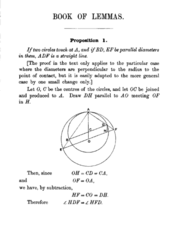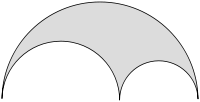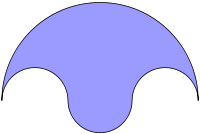
Book of Lemmas
Encyclopedia

Archimedes
Archimedes of Syracuse was a Greek mathematician, physicist, engineer, inventor, and astronomer. Although few details of his life are known, he is regarded as one of the leading scientists in classical antiquity. Among his advances in physics are the foundations of hydrostatics, statics and an...
by Thābit ibn Qurra
Thabit ibn Qurra
' was a mathematician, physician, astronomer and translator of the Islamic Golden Age.Ibn Qurra made important discoveries in algebra, geometry and astronomy...
, though the authorship of the book is questionable. It consists of fifteen propositions on circles.
Translations
The Book of Lemmas was first introduced in Arabic by Thābit ibn Qurra; he attributed the work to Archimedes. In 1661, the Arabic manuscript was translated into LatinLatin
Latin is an Italic language originally spoken in Latium and Ancient Rome. It, along with most European languages, is a descendant of the ancient Proto-Indo-European language. Although it is considered a dead language, a number of scholars and members of the Christian clergy speak it fluently, and...
by Abraham Ecchellensis
Abraham Ecchellensis
Ibrahim al-Haqilani was a Maronite Catholic philosopher and linguist involved in the translation of the Bible into Arabic...
and edited by Giovanni A. Borelli
Giovanni Alfonso Borelli
Giovanni Alfonso Borelli was a Renaissance Italian physiologist, physicist, and mathematician. He contributed to the modern principle of scientific investigation by continuing Galileo's custom of testing hypotheses against observation...
. The Latin version was published under the name Liber Assumptorum. T. L. Heath
T. L. Heath
Sir Thomas Little Heath was a British civil servant, mathematician, classical scholar, historian of ancient Greek mathematics, translator, and mountaineer. He was educated at Clifton College...
translated Heiburg's Latin work into English
English language
English is a West Germanic language that arose in the Anglo-Saxon kingdoms of England and spread into what was to become south-east Scotland under the influence of the Anglian medieval kingdom of Northumbria...
in his The Works of Archimedes.
Authorship
The original authorship of the Book of Lemmas has been in question because in proposition four, the book refers to Archimedes in third personGrammatical person
Grammatical person, in linguistics, is deictic reference to a participant in an event; such as the speaker, the addressee, or others. Grammatical person typically defines a language's set of personal pronouns...
; however, it has been suggested that it may have been added by the translator. Another possibility is that the Book of Lemmas may be a collection of propositions by Archimedes later collected by a Greek writer.
Arbelos

The figure is used in propositions four through eight. In propositions five, Archimedes introduces the Archimedes' twin circles, and in proposition eight, he makes use what would be the Pappus chain
Pappus chain
In geometry, the Pappus chain was created by Pappus of Alexandria in the 3rd century AD.-Construction:The arbelos is defined by two circles, CU and CV, which are tangent at the point A and where CU is enclosed by CV...
, formally introduced by Pappus of Alexandria
Pappus of Alexandria
Pappus of Alexandria was one of the last great Greek mathematicians of Antiquity, known for his Synagoge or Collection , and for Pappus's Theorem in projective geometry...
.
Salinon

Archimedes proved that the salinon and the circle are equal in area.
Propositions
- If two circles touch at A, and if CD, EF be parallel diameters in them, ADF is a straight line.
- Let AB be the diameter of a semicircle, and let the tangents to it at B and at any other point D on it meet in T. If now DE be drawn perpendicular to AB, and if AT, DE meet in F, then DF = FE.
- Let P be any point on a segment of a circle whose base is AB, and let PN be perpendicular to AB. Take D on AB so that AN = ND. If now PQ be an arc equal to the arc PA, and BQ be joined, then BQ, BD shall be equal.
- If AB be the diameter of a semicircle and N any point on AB, and if semicircles be described within the first semicircle and having AN, BN as diameters respectively, the figure included between the circumferences of the three semicircles is "what Archimedes called αρβηλος"; and its area is equal to the circle on PN as diameter, where PN is perpendicular to AB and meets the original semicircle in P.
- Let AB be the diameter of a semicircle, C any point on AB, and CD perpendicular to it, and let semicircles be described within the first semicircle and having AC, CB as diameters. Then if two circles be drawn touching CD on different sides and each touching two of the semicircles, the circles so drawn will be equal.
- Let AB, the diameter of a semicircle, be divided at C so that AC = 3/2 × CB [or in any ratio]. Describe semicircles within the first semicircle and on AC, CB as diameters, and suppose a circle drawn touching the all three semicircles. If GH be the diameter of this circle, to find relation between GH and AB.
- If circles are circumscribed about and inscribed in a square, the circumscribed circle is double of the inscribed square.
- If AB be any chord of a circle whose centre is O, and if AB be produced to C so that BC is equal to the radius; if further CO meets the circle in D and be produced to meet the circle the second time in E, the arc AE will be equal to three times the arc BD.
- If in a circle two chords AB, CD which do not pass through the centre intersect at right angles, then (arc AD) + (arc CB) = (arc AC) + (arc DB).
- Suppose that TA, TB are two tangents to a circle, while TC cuts it. Let BD be the chord through B parallel to TC, and let AD meet TC in E. Then, if EH be drawn perpendicular to BD, it will bisect it in H.
- If two chords AB, CD in a circle intersect at right angles in a point O, not being the centre, then AO2 + BO2 + CO2 + DO2 = (diameter)2.
- If AB be the diameter of a semicircle, and TP, TQ the tangents to it from any point T, and if AQ, BP be joined meeting in R, then TR is perpendicular to AB.
- If a diameter AB of a circle meet any chord CD, not a diameter, in E, and if AM, BN be drawn perpendicular to CD, then CN = DM.
- Let ACB be a semicircle on AB as diameter, and let AD, BE be equal lengths measured along AB from A, B respectively. On AD, BE as diameters describe semicircles on the side towards C, and on DE as diameter a semicircle on the opposite side. Let the perpendicular to AB through O, the centre of the first semicircle, meet the opposite semicircles in C, F respectively. Then shall the area of the figure bounded by the circumferences of all the semicircles be equal to the area of the circle on CF as diameter.
- Let AB be the diameter of a circle., AC a side of an inscribed regular pentagon, D the middle point of the arc AC. Join CD and produce it to meet BA produced in E; join AC, DB meeting in F, and Draw FM perpendicular to AB. Then EM = (radius of circle).

